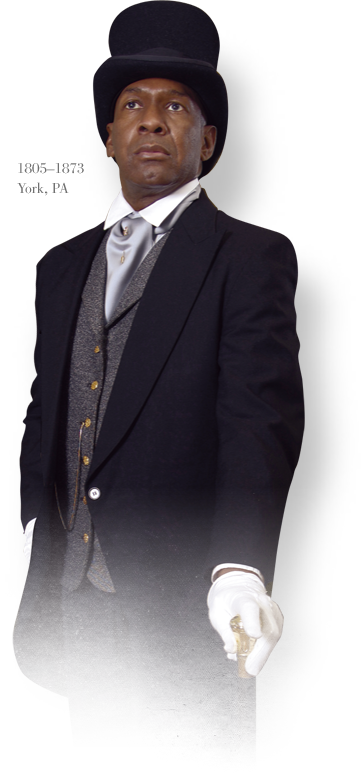William Goodridge
His Story
William Goodridge was born enslaved in Maryland to an African American mother and an unknown White father. Unfortunately little is known about his early years. Goodridge was sent to York, PA, in 1860 as an apprentice to a tanner. He was to be freed when he turned 21, but his master unexpectedly freed him when he was 16. Goodridge is said to have left York around 1822, and he learned the barber trade, possibly in Marietta, Pennsylvania. He returned to York between 1823 and 1825 and opened a barber shop on Centre Square, known today as Continental Square. The barber shop grew into a grand, sky lighted photography studio and emporium.
Historically, many free Blacks became barbers. It is also known that their clientele was very diverse, and sought-after barbers like Goodridge were able to interact with prominent White citizens who came to trust and respect him. According to research, Goodridge's interaction with influencial White businessmen allowed him to form relationships that informed his business decisions. Due to his successful business transactions, by 1845, Goodridge had become a wealthy and talented businessman in York.
Apart from being a retailer of various commodities, Goodridge owned about twenty commercial and residential properties in York. In 1847, he built a five-story building known as Centre Hall - the tallest building in York at the time. Goodridge is also credited with introducing the sale of daily newspapers in York. Eventually, he also entered the railroad businesses. Goodridge Reliance Line of Burthen Cars offered service between York, Philadelphia, and more than 20 other cities.
Goodridge put his wealth to good use by providing aid to the Underground Railroad. His railroad operation often moved enslaved people on the way to freedom. His network on the Underground Railroad made him a key “conductor” and “station master.” He befriended Frederick Douglass, John Brown, Frances Harper, Stephen Smith and other change agents. On the third floor of the Goodridge building in Centre Square Goodridge concealed Osborn Perry Anderson following his participation with John Brown in the 1859 insurrection at Harper’s Ferry. Anderson fled to Canada and was the only participant in that ill-fated event to survive thanks in part to Goodridge and members of Pennsylvania’s Underground Railroad.
After the Civil War, the record shows that Goodridge was a prosperous York businessman and his impact on the community continued. However, he spent his remaining years in Minnesota with his daughter’s family. He died on January 15, 1873 and lies in the Minneapolis Pioneers and Soldiers Memorial Cemetery. He was known as one of the most prominent Black men of his generation and his greatest legacy is his involvement in the Underground Railroad.

